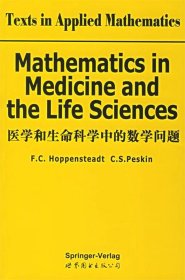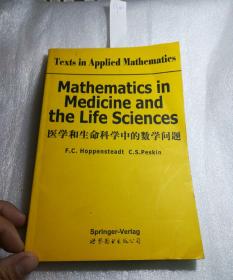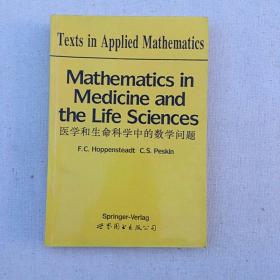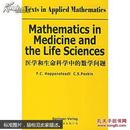
医学和生命科学中的数学问题(英文版)
医学和生命科学中的数学问题英文版
¥ 18.58 3.8折 ¥ 49 九品
仅1件
北京通州
认证卖家担保交易快速发货售后保障
作者F.C.Hoppensteadt、C.S.Peskin 编
出版社世界图书出版公司
出版时间1997-09
版次1
装帧平装
上书时间2024-05-06
- 最新上架
商品详情
- 品相描述:九品
图书标准信息
- 作者 F.C.Hoppensteadt、C.S.Peskin 编
- 出版社 世界图书出版公司
- 出版时间 1997-09
- 版次 1
- ISBN 9787506233040
- 定价 49.00元
- 装帧 平装
- 开本 其他
- 纸张 胶版纸
- 页数 252页
- 【内容简介】
- Mathematical Biology is the study of medicine and the life sciences that uses mathematical models to help predict and interpret what we observe. This book describes several major contributions that have been made to population biology and to physiology by such theoretical work. We have tried to keep the presentation brief to keep the price of the book as reasonable as possible, and to ensure that the topics are presented at a level that is accessible to a wide audience. Each topic could serve as a launching point for more advanced study, and suitable references are suggested to help with this. If the underlying mathematics is understood for these basic examples. then mathematical aspects of more advanced life science preblems will be within reach.
- 【目录】
-
Series Preface
Preface
Introduction
1 The Mathematics of Populations: Demographics
1.1. Geometric Population Growth
1.1.1. Growth of Bacterial Cultures
1.1.2. Least-Squares Estimation of the Growth Rate
1.1.3. Growth of Human Populations
1.1.4. Infinitesimal Sampling Intervals and Doubling Times
1.2. Geometric Growth in a Population Stratified by Age
1.2.1. Fibonacci's Rabbit Population
1.2.2. Euler's Renewal Equations
1.2.3. Age Structure in Human Popnlations
1.3. The Limits of Growth
1.3.1. Verhulst's Model
1.3.2. Predator Satiation
1.3.3. Chaos
1.3.4. Infimtesimal Sampling Intervals ina Limiting Environment
1.4. Age Structure of Populations near
the Limits of Growth
1.5. Harvesting
1.6. Summary
1.7. Annotated References
Exercises
2 Inheritance
2.1. Mendel's Laws
2.2. Bacterial Genetics: Plasmids
2.3. Genetics in Small Populations of Human.
2.4. The Hardy-Weinberg Equilibrium
2.5. Summary
2.6. Annotated References
Exercises
3 A Theory of Epidemics
3.1. Spread of Infection within a Family
3.2. The Threshold of an Epidemic
3.3. Calculation of the Severity of an Epidemic
3.4. Summary
3.5. Annotated References
Exercises
4 Biogeography
4.1. TheGameofLife.
4.2. Random Walks
4.3. The Diffusion Apprcndmation
4.4. The Growth of Bacteria on Plates
4.5. Another View of Random Walks
4.6. Summary
4.7. Annotated References
Exercises
5 The Heart and Circulation
5.1. Plan of the Circulation
5.2. Volume, Flow, and Pressure
5.3. Resistance and Compliance Vessels
5.4. The Heart as a Pair of Pumps
5.5. Mathematical Model of the Uncontrolled Circulation
5.6. Balancing the Two Sides of the Heart andthe Two Circulations
5.7. Cardiac Output and Arterial Blood Pressure:The Need for Extemal Circulatory Control Mechanisms
5.8. Neural Control: The Baroreceptor Loop
5.9. Autoregulation
5.10. Changes in the Circulation Occurring at Birth
5.11. Dynamics of the Arterial Pulse
5.12. Annotated References,
Exercises
6 Gas Exchange in the Lungs
6.1. The Ideal Gas Law and the Solubility of Gases
6.2. The Equations of Gas Transport in One Alveolus.
6.3. Gas Transport in the Lung
6.4. Optimal Gas TRansport
6.5. Mean Alveolar and Arterial Partial Pressures
6.6. Transport of O2
6.7. Annotated References
Exercises
7 Control of Cell Volume anathe Electrical Properties of Cell Membranes
7.1. Osmotic Pressure and the Work of Concentration
7.2. A Simple Model of Cell Volume Control
7.3. The Movement of lons across Cell Membranes
7.4. Control of Cell Volume: The Interaction ofElectrical and Osmotic Effects
7.5. Transient Changes in Membrane Potential:A Signaling Mechanism in Nerve and Muscle
7.6. Annotated References
Exercises
8 The Renal Countercurrent Mechanism
8.1. The Nephron
8.2. Differential Equations of Na+ and H2o Transportalong the Renal Tubules
8.3. The Loop of Henle
8.4. The Juxtaglomerular Apparatus andthe Renin-Angiotensin System
8.5. The Distal Tubule and Collecting Duct:Concentrating and Diluting Modes
8.6. Remarks on the Significance ofthe Juxtaglomerular Apparatus
8.7. Annotated References
Exercises
9 Muscle Mechanics
9.1. The Force-Velocity Curve
9.2. Cross-Bridge Dynamics
9.3. Annotated References
Exercises
10 Biological Clocks and Mechanismsof Neural Control
10.1. A Theory of Clocks
10.1.1.The Clock on the Wall
10.1.2. Pbase Resetting: A Rubber Handed CIock
10.1.3. Modulated Clocks
10.2. Nerve Cell Membranes
10.2.1. Cell Membrane Potential
10.2.2. Guttman's Experiments
10.3. VCON: A Voltage Controlled Oscillator Neuron
10.3.1. Voltage Controlled Oscillators
10.3.2. Phase Comparators and a Model Synapse.
10.3.3. VCON: A Model Spike Generator
10.3.4. Phase Locking Properties of a VCON
10.4. Neural Control Networks
10.4.1. Network Nqtation
10.4.2. von Euler's Respiration Control Mechanism.
10.5. Summary
10.6. Annotated References
Exercises
Answers for Selected Exercises
Index
点击展开
点击收起
相关推荐
— 没有更多了 —












![医学和生命科学数学 [英文]](https://www0.kfzimg.com/sw/kfzimg/2568/02195b2b3a696ea4b3_s.jpg)
![医学和生命科学数学 [英文]](https://www0.kfzimg.com/sw/kfzimg/2288/01cd8a0bd6d84f5f11_s.jpg)








以下为对购买帮助不大的评价